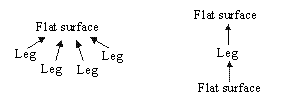
Returning to our 'table' example, the typical approach to Conceptual Evolutionary Design would be to devise a number of conceptual building blocks, each having a specific behaviour, and evolution would find a suitable organisation of the blocks to ensure that the whole design behaves as a table, see below.
Conceptual Building Blocks:

Phenotypes:

Genotype:
|
0000 1111 |
0001 0000 |
0001 0000 |
0001 0000 |
0001 0000 |
|
Concept1 Ptr1 |
Concept2 Ptr2 |
Concept3 Ptr3 |
Concept4 Ptr4 |
Concept5 Ptr5 |
Figure. Conceptual Evolutionary Design of a table.
The example uses only two conceptual building blocks: Flat surface and Leg, each of which have their behaviours defined. Phenotypes consist of networks of these concepts. The figure shows the phenotype representation of a four-legged table (middle left) and a table with its table top resting on a single pedestal with a wide base (middle right). If GP is used to evolve these designs, the phenotypes could be directly modified, and the number of concepts would be variable. If a GA is used to evolve the designs, a genotype representation similar to the one shown in the figure would be required. It should be clear that, unlike Evolutionary Optimisation, Conceptual Evolutionary Design is capable of generating new design concepts. However, such systems are inevitably limited to the building blocks and their functions provided by the designer.